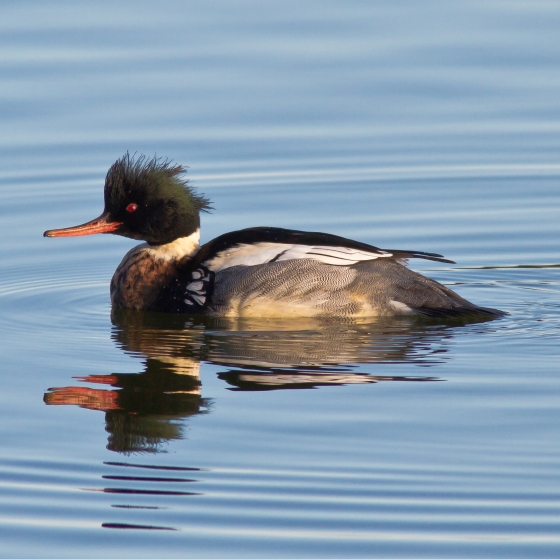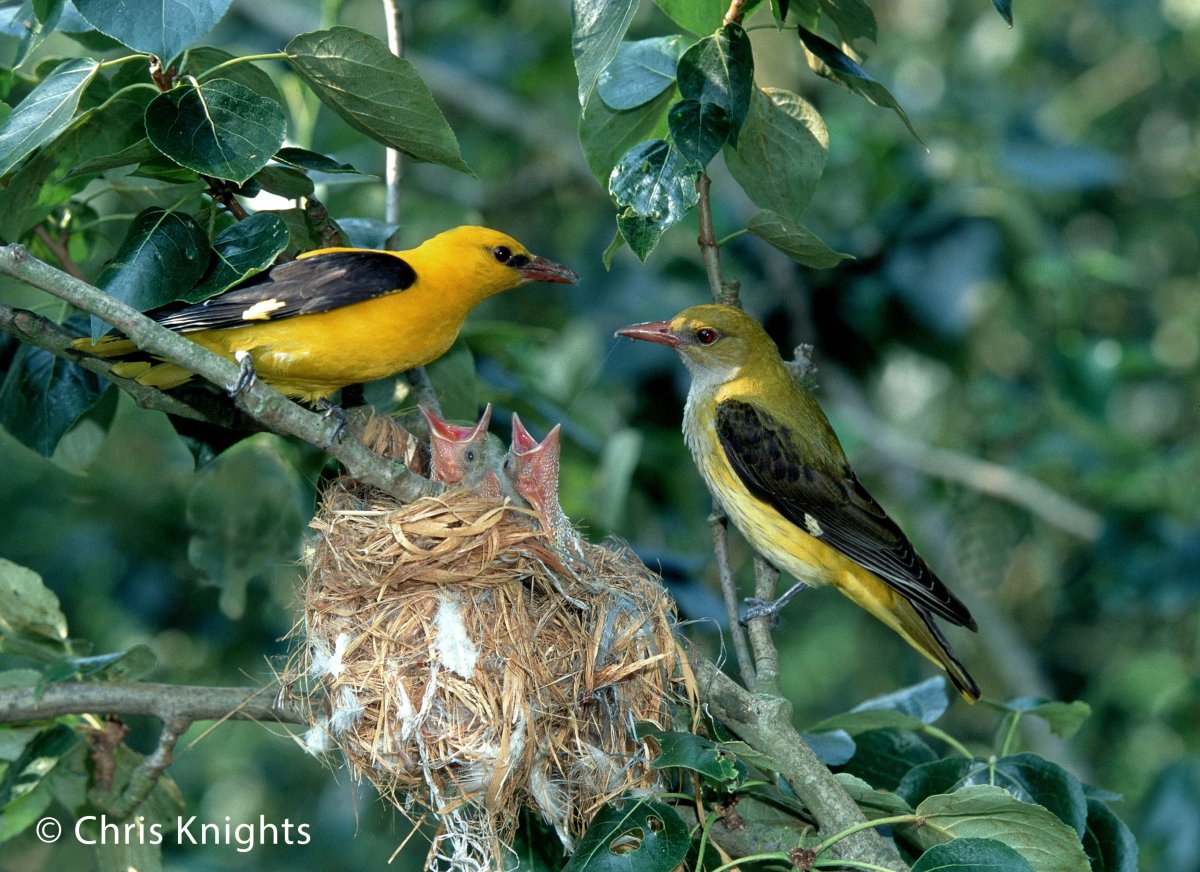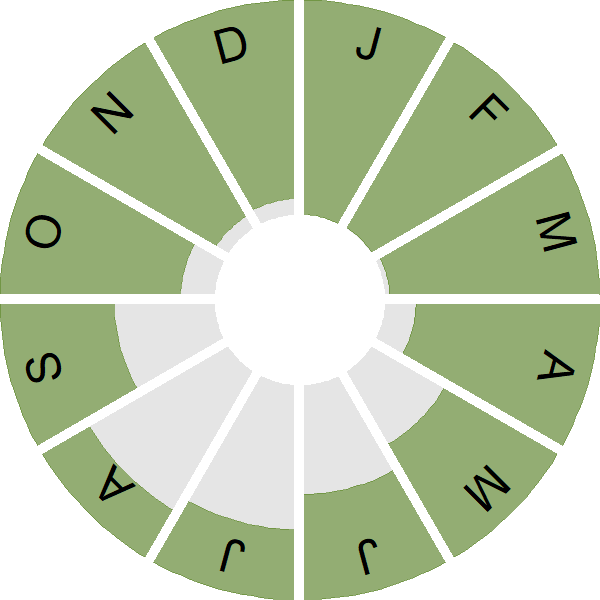Red-breasted Merganser

Introduction
One of three species of 'sawbill' that regularly occur in the UK, the Red-breasted Merganser can be told by its punk-style 'hairdo', glossy green in the male and rusty orange-red in the female.
The small breeding population is found mainly on Scottish lochs but pairs also use favoured waterbodies in western Britain and in Ireland.
Like many wildfowl, numbers grow during the winter and a wintering population of over 10,000 birds is not unusual. During the winter the Red-breasted Merganser is found almost exclusively on the sea, hunting small fish close to shore; Bird Atlas 2007–11 underlines that the species can be seen almost anywhere around our coast.

Key Stats
Identification
ID Videos
This section features BTO training videos headlining this species, or featuring it as a potential confusion species.
Goosander and Red-breasted Merganser
Songs and Calls
Call:
Status and Trends
Conservation Status
Population Change
Red-breasted Merganser was added to the list of species monitored by the RBBP in 2017, after the British breeding population was estimated at 1,565 (1,373–1,754) pairs (Humphreys et al. 2016). The main breeding strongholds are in Scotland (1,432 pairs), with smaller breeding concentrations also occurring in parts of northern England, north Wales and northern Ireland. Population trends are unclear but the breeding range has decreased by 28% since 1968–72 (Balmer et al. 2013).
Distribution
In winter, Red-breasted Mergansers are widely distributed around the coast of Britain & Ireland, with distinct concentrations off western Scotland, the Northern Isles, northwest and southwest Ireland, north Wales and the Solent. In the breeding season they are more concentrated in the Scottish Isles, northwest Scotland, parts of north and west Ireland, northern England and northwest Wales.
Occupied 10-km squares in UK
or view it on Bird Atlas Mapstore.
or view it on Bird Atlas Mapstore.
European Distribution Map
Distribution Change
The breeding range of the Red-breasted Merganser has contracted by 28% since the 1968–72 Breeding Atlas, with losses concentrated in western Ireland, southwest Scotland and many inland parts of Scotland, particularly in the east and far north.
Change in occupied 10-km squares in the UK
or view it on Bird Atlas Mapstore.
or view it on Bird Atlas Mapstore.
Seasonality
Red-breasted Mergansers are present year-round, with wintering birds on many coasts and a localised breeder in the north.
Weekly pattern of occurrence
The graph shows when the species is present in the UK, with taller bars indicating a higher likelihood of encountering the species in appropriate regions and habitats.

Movement
Britain & Ireland movement
Foreign locations of birds ringed or recovered in Britain & Ireland
Dots show the foreign destinations of birds ringed in Britain & Ireland, and the origins of birds ringed overseas that were subsequently recaptured, resighted or found dead in Britain & Ireland. Dot colours indicate the time of year that the species was present at the location.
- Winter (Nov-Feb)
- Spring (Mar-Apr)
- Summer (May-Jul)
- Autumn (Aug-Oct)

European movements
EuroBirdPortal uses birdwatcher's records, such as those logged in BirdTrack to map the flows of birds as they arrive and depart Europe. See maps for this species here.
The Eurasian-African Migration Atlas shows movements of individual birds ringed or recovered in Europe. See maps for this species here.
Biology
Productivity and Nesting
Nesting timing
Egg measurements
Clutch Size
Survival and Longevity
Survival is shown as the proportion of birds surviving from one year to the next and is derived from bird ringing data. It can also be used to estimate how long birds typically live.
View number ringed each year in the Online Ringing Report.
lifespan
Biometrics
Wing length and body weights are from live birds (source).
Ring Size
Classification, names and codes
Classification and Codes
- Order: Anseriformes
- Family: Anatidae
- Scientific name: Mergus serrator
- Authority: Linnaeus, 1758
- BTO 2-letter code: RM
- BTO 5-letter code: REBME
- Euring code number: 2210
Alternate species names
- Catalan: bec de serra mitjà
- Czech: morcák prostrední
- Danish: Toppet Skallesluger
- Dutch: Middelste Zaagbek
- Estonian: rohukoskel
- Finnish: tukkakoskelo
- French: Harle huppé
- Gaelic: Sìolta-dhearg
- German: Mittelsäger
- Hungarian: örvös bukó
- Icelandic: Toppönd
- Irish: Síolta Rua
- Italian: Smergo minore
- Latvian: garknabja gaura, melgale
- Lithuanian: vidutinis danciasnapis
- Norwegian: Siland
- Polish: szlachar
- Portuguese: merganso-de-poupa
- Slovak: potápac prostredný
- Slovenian: srednji žagar
- Spanish: Serreta mediana
- Swedish: småskrake
- Welsh: Hwyaden Frongoch
Research
Causes of Change and Solutions
Causes of change
The breeding population trend is unclear: range declines suggest that a population decline may have occurred but there are insufficient data to confirm this. Causes of the possible decline are also unknown, although there are concerns about the potential impact of piscivorous birds, including Red-breasted Merganser, on fisheries and licensed control of fish-eating birds is available to reduce potential economic losses (Humphreys et al. 2016).
Publications (2)
The risk of extinction for birds in Great Britain
Author: Stanbury, A., Brown, A., Eaton, M., Aebischer, N., Gillings, S., Hearn, R., Noble, D., Stroud, D. & Gregory, R.
Published: 2017
The UK has lost seven species of breeding birds in the last 200 years. Conservation efforts to prevent this from happening to other species, both in the UK and around the world, are guided by species’ priorities lists, which are often informed by data on range, population size and the degree of decline or increase in numbers. These are the sorts of data that BTO collects through its core surveys.
01.09.17
Papers

Abundance, distribution and habitat use of Goosanders Mergus merganser and Red-breasted Mergansers Mergus serrator on British rivers
Author: Gregory, R.D., Carter, S.P. & Baillie, S.R.
Published: 1997
01.01.97
Papers

